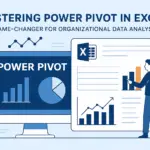Data Analysis in Small vs Large Organizations: Key Differences
In today’s data-driven world, businesses of all sizes rely on data analysis in small vs large organizations to gain insights, make informed decisions, and improve performance. However, the approach to data analysis reveals important differences in resources, scale, tools, and strategy.
Understanding these differences is essential for choosing the right approach to data management based on your organization’s size and goals. For more on why data is foundational to decision-making, check out The Importance of Data Analysis in an Organization.
Resources and Infrastructure in Small vs Large Organizations
Small Organizations:
- Often operate with limited budgets and smaller teams.
- Rely heavily on cost-effective tools like Microsoft Excel or Google Sheets.
- May not have dedicated data analysts; data tasks are often handled by general staff.
Large Organizations:
- Invest in robust infrastructure (data warehouses, BI platforms, cloud storage).
- Employ specialized teams: data analysts, engineers, and scientists.
- Use advanced tools like Power BI, Tableau, and Python/R for analysis.
The difference in data analysis infrastructure significantly impacts how data is collected, cleaned, and used.
Scope and Complexity of Data Analysis in Organizations
Small Organizations:
- Deal with lower data volumes.
- Focus analysis on immediate operational issues (e.g., inventory, sales, customer feedback).
- Reporting is usually simpler and more frequent.
Large Organizations:
- Handle massive datasets from multiple departments and regions.
- Analyze trends across longer periods and broader scopes.
- Develop complex models for forecasting, segmentation, and risk analysis.
The scale of data analysis in small vs large organizations often correlates with the level of strategic planning and prediction required.
Tools and Automation: A Contrast Between Small and Large Organizations
Small Organizations:
- Depend on manual or semi-automated processes.
- Use macros, basic scripting, or plug-ins to enhance productivity.
Large Organizations:
- Leverage fully automated pipelines and cloud-based data solutions.
- Integrate AI/ML tools for deeper analysis and real-time insights.
To learn more about industry-standard BI tools, visit Microsoft Power BI or Tableau.
Automation in large organizations allows for scalability and consistency that smaller setups often can’t match.
Culture and Agility in Small vs Large Organizations
Small Organizations:
- More agile and able to act quickly on insights.
- Easier to implement data-driven changes due to fewer decision layers.
Large Organizations:
- More structured and process-heavy.
- Data-driven changes can be slower due to bureaucracy and multiple stakeholders.
However, large organizations often have the strategic frameworks to support long-term data integration.
Final Thoughts on Data Analysis in Small vs Large Organizations
Both small and large organizations can benefit immensely from data analysis, but the approach must fit the context.
- Small businesses should focus on efficiency, clarity, and flexibility.
- Large enterprises should optimize scalability, integration, and governance.
Understanding the key differences between data analysis in small organizations vs large organizations helps align your resources and expectations for maximum value.
Want help tailoring your data analysis tools to your organization’s size? Let’s connect.



